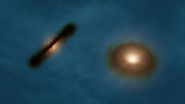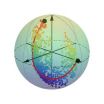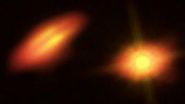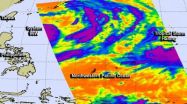(Press-News.org) The shape of the moon deviates from a simple sphere in ways that scientists have struggled to explain. A new study by researchers at UC Santa Cruz shows that most of the moon's overall shape can be explained by taking into account tidal effects acting early in the moon's history.
The results, published July 30 in Nature, provide insights into the moon's early history, its orbital evolution, and its current orientation in the sky, according to lead author Ian Garrick-Bethell, assistant professor of Earth and planetary sciences at UC Santa Cruz.
As the moon cooled and solidified more than 4 billion years ago, the sculpting effects of tidal and rotational forces became frozen in place. The idea of a frozen tidal-rotational bulge, known as the "fossil bulge" hypothesis, was first described in 1898. "If you imagine spinning a water balloon, it will start to flatten at the poles and bulge at the equator," Garrick-Bethell explained. "On top of that you have tides due to the gravitational pull of the Earth, and that creates sort of a lemon shape with the long axis of the lemon pointing at the Earth."
But this fossil bulge process cannot fully account for the current shape of the moon. In the new paper, Garrick-Bethell and his coauthors incorporated other tidal effects into their analysis. They also took into account the large impact basins that have shaped the moon's topography, and they considered the moon's gravity field together with its topography.
Efforts to analyze the moon's overall shape are complicated by the large basins and craters created by powerful impacts that deformed the lunar crust and ejected large amounts of material. "When we try to analyze the global shape of the moon using spherical harmonics, the craters are like gaps in the data," Garrick-Bethell said. "We did a lot of work to estimate the uncertainties in the analysis that result from those gaps."
Their results indicate that variations in the thickness of the moon's crust caused by tidal heating during its formation can account for most of the moon's large-scale topography, while the remainder is consistent with a frozen tidal-rotational bulge that formed later.
A previous paper by Garrick-Bethell and some of the same coauthors described the effects of tidal stretching and heating of the moon's crust at a time 4.4 billion years ago when the solid outer crust still floated on an ocean of molten rock. Tidal heating would have caused the crust to be thinner at the poles, while the thickest crust would have formed in the regions in line with the Earth. Published in Science in 2010, the earlier study found that the shape of one area of unusual topography on the moon, the lunar farside highlands, was consistent with the effects of tidal heating during the formation of the crust.
"In 2010, we found one area that fits the tidal heating effect, but that study left open the rest of the moon and didn't include the tidal-rotational deformation. In this paper we tried to bring all those considerations together," Garrick-Bethell said.
Tidal heating and tidal-rotational deformation had similar effects on the moon's overall shape, giving it a slight lemon shape with a bulge on the side facing the Earth and another bulge on the opposite side. The two processes left distinct signatures, however, in the moon's gravity field. Because the crust is lighter than the underlying mantle, gravity signals reveal variations in the thickness of the crust that were caused by tidal heating.
Interestingly, the researchers found that the moon's overall gravity field is no longer aligned with the topography, as it would have been when the tidal bulges were frozen into the moon's shape. The principal axis of the moon's overall shape (the long axis of the lemon) is now separated from the gravity principal axis by about 34 degrees. (Excluding the large basins from the data, the difference is still about 30 degrees.)
"The moon that faced us a long time ago has shifted, so we're no longer looking at the primordial face of the moon," Garrick-Bethell said. "Changes in the mass distribution shifted the orientation of the moon. The craters removed some mass, and there were also internal changes, probably related to when the moon became volcanically active."
The details and timing of these processes are still uncertain. But Garrick-Bethell said the new analysis should help efforts to work out the details of the moon's early history. While the new study shows that tidal effects can account for the overall shape of the moon, tidal processes don't explain the topographical differences between the near side and the far side.
INFORMATION:
In addition to Garrick-Bethell, the coauthors of the paper include Viranga Perera, who worked on the study as a UCSC graduate student and is now at Arizona State University; Francis Nimmo, professor of Earth and planetary sciences at UCSC; and Maria Zuber, a planetary scientist at the Massachusetts Institute of Technology. This work was funded by the Ministry of Education of Korea through the National Research Foundation.
Tidal forces gave moon its shape, according to new analysis
2014-07-30
ELSE PRESS RELEASES FROM THIS DATE:
Target growth-driving cells within tumors, not fastest-proliferating cells
2014-07-30
BOSTON –– Of the many sub-groups of cells jockeying for supremacy within a cancerous tumor, the most dangerous may not be those that can proliferate the fastest, researchers at Dana-Farber Cancer Institute report in a paper appearing in an advance online publication of the journal Nature. The findings have important implications for the treatment of cancer with precision medicines, the study authors explained: Doctors need to ascertain which cell subgroups are truly driving the tumor's growth and metastasis and select drugs that target the critical genes within those cells. ...
ALMA finds double star with weird and wild planet-forming discs
2014-07-30
BOWLING GREEN, O.—From movies to television, obesity is still considered "fair game" for jokes and ridicule. A new study from researchers at Bowling Green State University took a closer look at weight-related humor to see if anti-fat attitudes played into a person's appreciation or distaste for fat humor in the media.
"Weight-Related Humor in the Media: Appreciation, Distaste and Anti-Fat Attitudes," by psychology Ph.D. candidate Jacob Burmeister and Dr. Robert Carels, professor of psychology, is featured in the June issue of Psychology of Popular Media Culture.
Carels ...
Innovative scientists update old-school pipetting with new-age technology
2014-07-30
CAMBRIDGE, Mass. (July 30, 2014) A team of Whitehead Institute researchers is bringing new levels of efficiency and accuracy to one of the most essential albeit tedious tasks of bench science: pipetting. And, in an effort to aid the scientific community at large, the group has established an open source system that enables anyone to benefit from this development free of charge.
Dubbed "iPipet," the system converts an iPad or any tablet computer into a "smart bench" that guides the execution of complex pipetting protocols. iPipet users can also share their pipetting designs ...
Mapping the optimal route between 2 quantum states
2014-07-30
As a quantum state collapses from a quantum superposition to a classical state or a different superposition, it will follow a path known as a quantum trajectory. For each start and end state there is an optimal or "most likely" path, but it is not as easy to predict the path or track it experimentally as a straight-line between two points would be in our everyday, classical world.
In a new paper featured this week on the cover of Nature, scientists from the University of Rochester, University of California at Berkeley and Washington University in St. Louis have shown ...
Young binary star system may form planets with weird and wild orbits
2014-07-30
Unlike our solitary Sun, most stars form in binary pairs -- two stars that orbit a common center of mass. Though remarkably plentiful, binaries pose a number of questions, including how and where planets form in such complex environments.
While surveying a series of binary stars with the Atacama Large Millimeter/submillimeter Array (ALMA), astronomers uncovered a striking pair of wildly misaligned planet-forming disks in the young binary star system HK Tau. These results provide the clearest picture ever of protoplanetary disks around a double star and could reveal important ...
Scientists reproduce evolutionary changes by manipulating embryonic development of mice
2014-07-30
A group of researchers from the University of Helsinki and the Universitat Autònoma de Barcelona have been able experimentally to reproduce in mice morphological changes which have taken millions of years to occur. Through small and gradual modifications in the embryonic development of mice teeth, induced in the laboratory, scientists have obtained teeth which morphologically are very similar to those observed in the fossil registry of rodent species which separated from mice millions of years ago.
To modify the development of their teeth, the team from the Institute ...
Conservation scientists asking wrong questions on climate change impacts on wildlife
2014-07-30
Scientists studying the potential effects of climate change on the world's animal and plant species are focusing on the wrong factors, according to a new paper by a research team from the Wildlife Conservation Society, University of Queensland, and other organizations. The authors claim that most of the conservation science is missing the point when it comes to climate change.
While the majority of climate change scientists focus on the "direct" threats of changing temperatures and precipitation after 2031, far fewer researchers are studying how short-term human adaptation ...
Antarctic ice sheet is result of CO2 decrease, not continental breakup
2014-07-30
DURHAM, N.H. – Climate modelers from the University of New Hampshire have shown that the most likely explanation for the initiation of Antarctic glaciation during a major climate shift 34 million years ago was decreased carbon dioxide (CO2) levels. The finding counters a 40-year-old theory suggesting massive rearrangements of Earth's continents caused global cooling and the abrupt formation of the Antarctic ice sheet. It will provide scientists insight into the climate change implications of current rising global CO2 levels.
In a paper published today in Nature, Matthew ...
NASA catches two tropical troublemakers in Northwestern Pacific: Halong and 96W
2014-07-30
There are two tropical low pressure areas in the Northwestern Pacific Ocean today and they're close enough to each other to be captured in one image generated from data gathered by NASA's Aqua satellite.
NASA's Aqua satellite flew over both Tropical Storm Halong and developing System 96W early on July 30 and the Atmospheric Infrared Sounder (AIRS) instrument captured infrared data on them in one image. Both systems show powerful thunderstorms stretching high into the troposphere with cloud top temperatures as cold as -63F/-52C. Those thunderstorms have the potential for ...
Watching Schrödinger's cat die (or come to life)
2014-07-30
One of the famous examples of the weirdness of quantum mechanics is the paradox of Schrödinger's cat.
If you put a cat inside an opaque box and make his life dependent on a random event, when does the cat die? When the random event occurs, or when you open the box?
Though common sense suggests the former, quantum mechanics – or at least the most common "Copenhagen" interpretation enunciated by Danish physicist Neils Bohr in the 1920s – says it's the latter. Someone has to observe the result before it becomes final. Until then, paradoxically, the cat is both dead and ...






